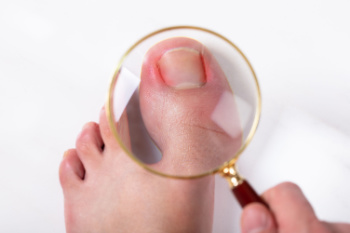
An ingrown toenail occurs when the edge of the toenail grows into the surrounding skin, often resulting in noticeable discomfort. Visually, it appears as redness, swelling, and tenderness around the edge of the toenail, which may become inflamed or infected if left untreated. In some cases, pus or a discharge might be visible. The primary sensation is sharp, throbbing pain along the affected area, which can worsen when pressure is applied, such as from walking or wearing tight shoes. The discomfort can range from mild irritation to severe pain, making it difficult to perform daily activities. Treatment for an ingrown toenail starts with home remedies like soaking the foot in warm, soapy water to reduce inflammation and soften the nail. Gently lifting the edge of the nail with a cotton ball or dental floss may help. Wearing comfortable, well-fitting shoes is important. If symptoms persist or show signs of infection, it is suggested you contact a podiatrist for possible surgical intervention or prescription treatments.
Ingrown toenails can become painful if they are not treated properly. For more information about ingrown toenails, contact Stephen Boykins, DPM of SoCal Podiatry, P.C.. Our doctor can provide the care you need to keep you pain-free and on your feet.
Ingrown Toenails
Ingrown toenails occur when a toenail grows sideways into the bed of the nail, causing pain, swelling, and possibly infection.
Causes
- Bacterial infections
- Improper nail cutting such as cutting it too short or not straight across
- Trauma to the toe, such as stubbing, which causes the nail to grow back irregularly
- Ill-fitting shoes that bunch the toes too close together
- Genetic predisposition
Prevention
Because ingrown toenails are not something found outside of shoe-wearing cultures, going barefoot as often as possible will decrease the likeliness of developing ingrown toenails. Wearing proper fitting shoes and using proper cutting techniques will also help decrease your risk of developing ingrown toenails.
Treatment
Ingrown toenails are a very treatable foot condition. In minor cases, soaking the affected area in salt or antibacterial soaps will not only help with the ingrown nail itself, but also help prevent any infections from occurring. In more severe cases, surgery is an option. In either case, speaking to your podiatrist about this condition will help you get a better understanding of specific treatment options that are right for you.
If you have any questions please feel free to contact our offices located in Downey and Moreno Valley, CA . We offer the newest diagnostic and treatment technologies for all your foot and ankle needs.
